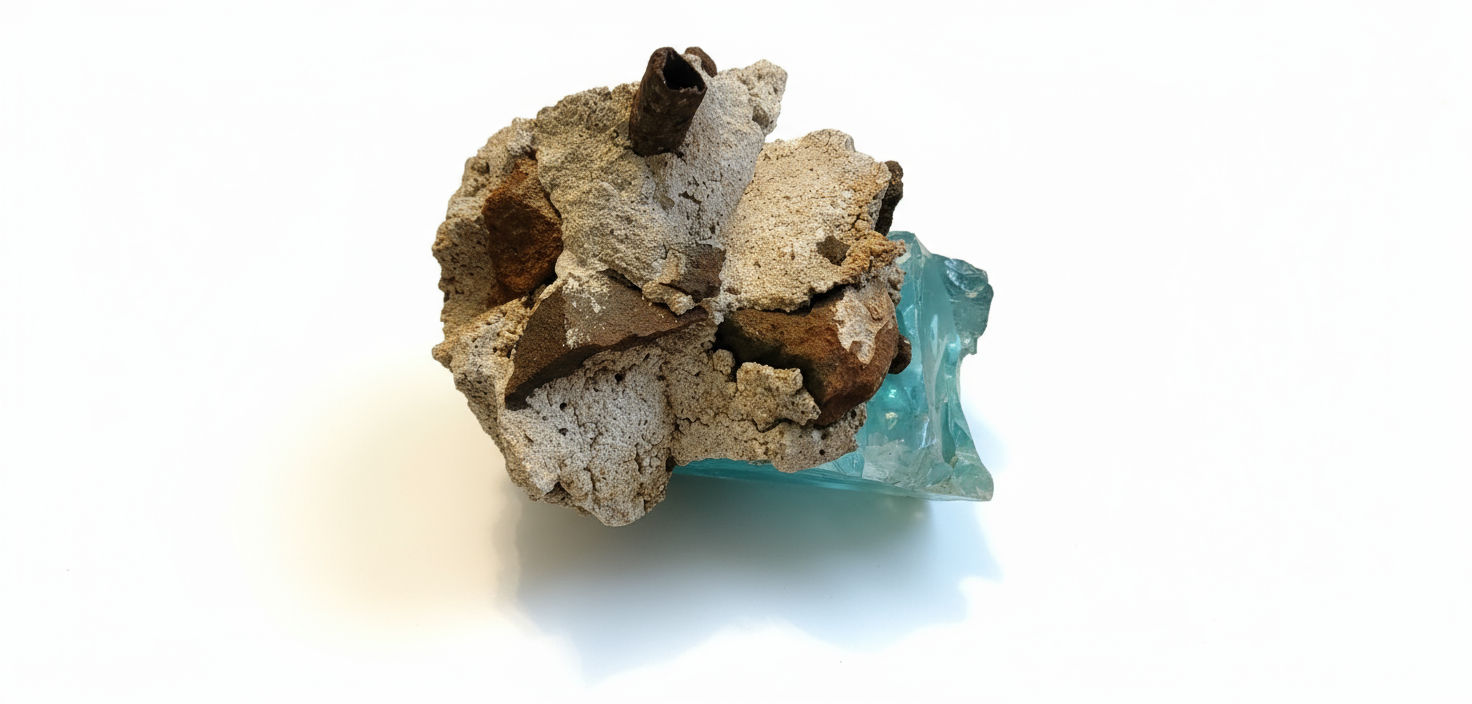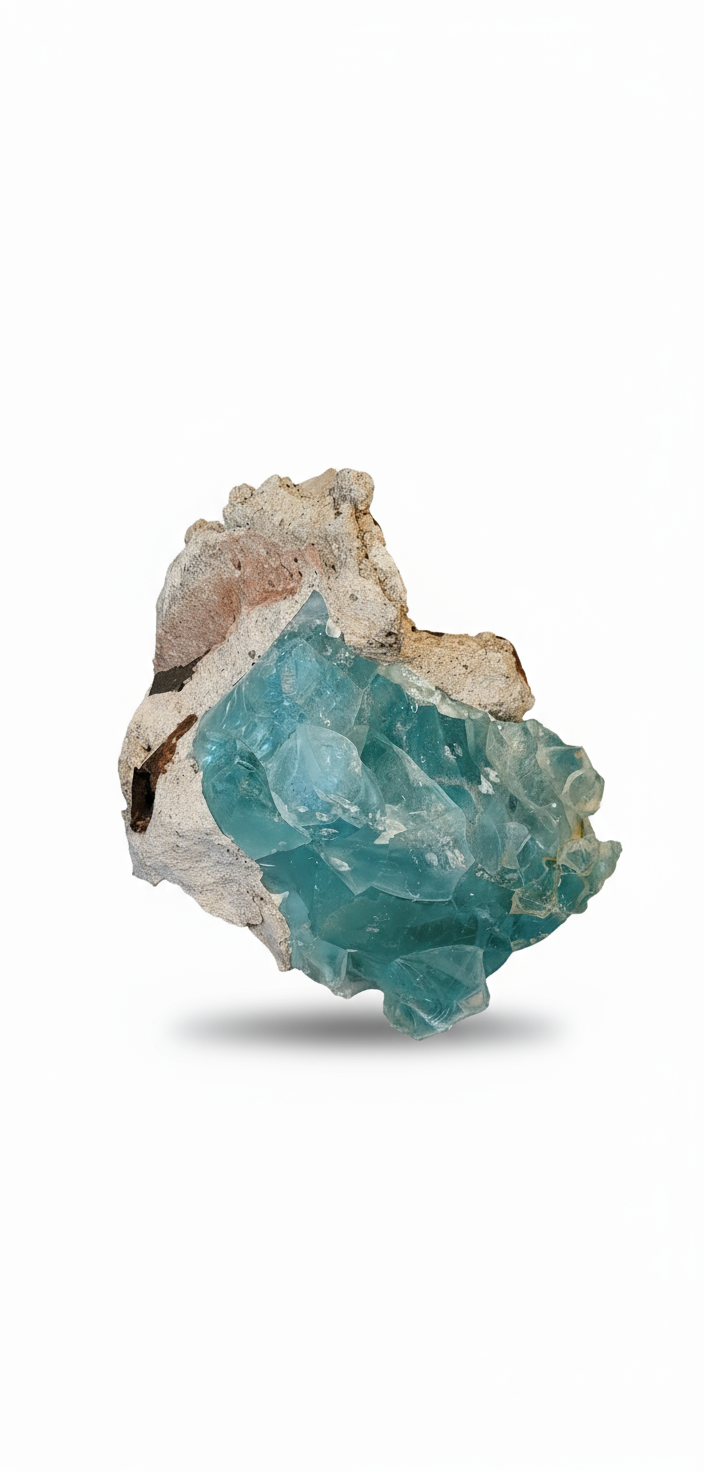

Cullet Slag from the late Bavinger Home
Blue Cullet Slag with Bavinger House Inclusion
Medium: Blue Glass Cullet Slag with Embedded Bavinger House Material Origin: Henrietta, Oklahoma Glass Plant Period of Use: Mid-1950s Provenance: Bavinger House, Norman, Oklahoma (Designed by Bruce Goff, 1950–1955)
The Story: Glass that Built a Legend
This object is a true architectural relic, a piece of the brilliant, eccentric palette used by architect Bruce Goff and owners Eugene and Nancy Bavinger in the construction of their legendary, now-demolished Bavinger House.
The walls of the spiral home were built from locally quarried ironstone, but Goff intentionally punctuated the rough, earthy stone with large, vibrant chunks of discarded "Blue Cullet Slag"—the brilliant, semi-opaque byproduct of glass manufacturing. This translucent material infused the house with a distinctive, magical, blue-green glow when the sun shone through it, transforming the interior space into a cave of colored light.
This specific piece of cullet slag originated from a glass plant in Henrietta, Oklahoma in the mid-1950s, highlighting Goff's commitment to using found, regional, and industrial materials in his Organic Architecture.
The Object: A Fragment of Lost History
What makes this particular piece an extraordinary artifact is the rare inclusion of a remnant of the Bavinger House structure itself—such as a piece of mortar, or ironstone—permanently fused to or encased within the blue glass.
Luminous Materiality: The stunning, ethereal blue-green color of the cullet is characteristic of Goff’s vision, where "junk" was elevated to high art.
Irreplaceable Provenance: This piece is a tangible fragment of the unique and celebrated architecture that defined Goff's masterpiece. It represents both the artistic materials used and the structure itself, forever embedding a piece of the legendary wall within the material that gave it light.
The Power of Memory: Since the Bavinger House was tragically demolished in 2016, relics of its material history are increasingly rare and represent a final, luminous testament to a building that redefined what a home could be.
A profound and beautiful artifact for architectural historians, collectors of Mid-Century Modern design, and devotees of the visionary Bruce Goff.
Blue Cullet Slag with Bavinger House Inclusion
Medium: Blue Glass Cullet Slag with Embedded Bavinger House Material Origin: Henrietta, Oklahoma Glass Plant Period of Use: Mid-1950s Provenance: Bavinger House, Norman, Oklahoma (Designed by Bruce Goff, 1950–1955)
The Story: Glass that Built a Legend
This object is a true architectural relic, a piece of the brilliant, eccentric palette used by architect Bruce Goff and owners Eugene and Nancy Bavinger in the construction of their legendary, now-demolished Bavinger House.
The walls of the spiral home were built from locally quarried ironstone, but Goff intentionally punctuated the rough, earthy stone with large, vibrant chunks of discarded "Blue Cullet Slag"—the brilliant, semi-opaque byproduct of glass manufacturing. This translucent material infused the house with a distinctive, magical, blue-green glow when the sun shone through it, transforming the interior space into a cave of colored light.
This specific piece of cullet slag originated from a glass plant in Henrietta, Oklahoma in the mid-1950s, highlighting Goff's commitment to using found, regional, and industrial materials in his Organic Architecture.
The Object: A Fragment of Lost History
What makes this particular piece an extraordinary artifact is the rare inclusion of a remnant of the Bavinger House structure itself—such as a piece of mortar, or ironstone—permanently fused to or encased within the blue glass.
Luminous Materiality: The stunning, ethereal blue-green color of the cullet is characteristic of Goff’s vision, where "junk" was elevated to high art.
Irreplaceable Provenance: This piece is a tangible fragment of the unique and celebrated architecture that defined Goff's masterpiece. It represents both the artistic materials used and the structure itself, forever embedding a piece of the legendary wall within the material that gave it light.
The Power of Memory: Since the Bavinger House was tragically demolished in 2016, relics of its material history are increasingly rare and represent a final, luminous testament to a building that redefined what a home could be.
A profound and beautiful artifact for architectural historians, collectors of Mid-Century Modern design, and devotees of the visionary Bruce Goff.
